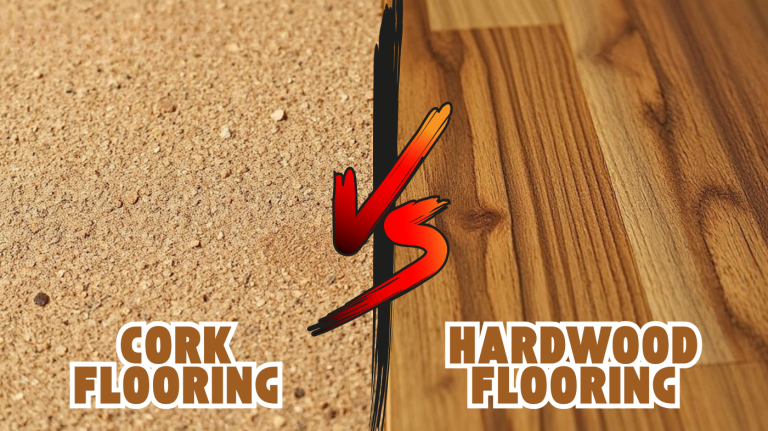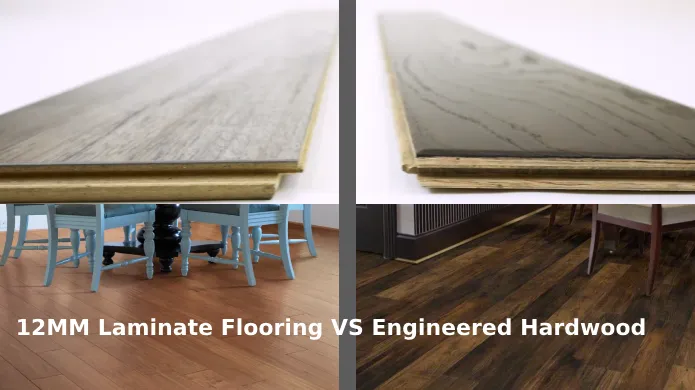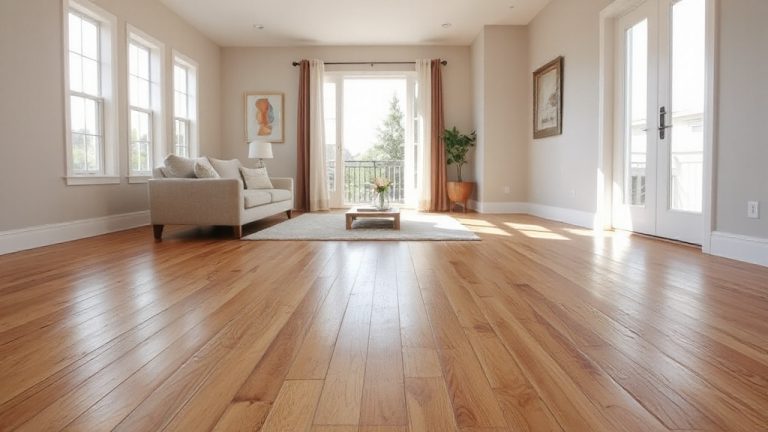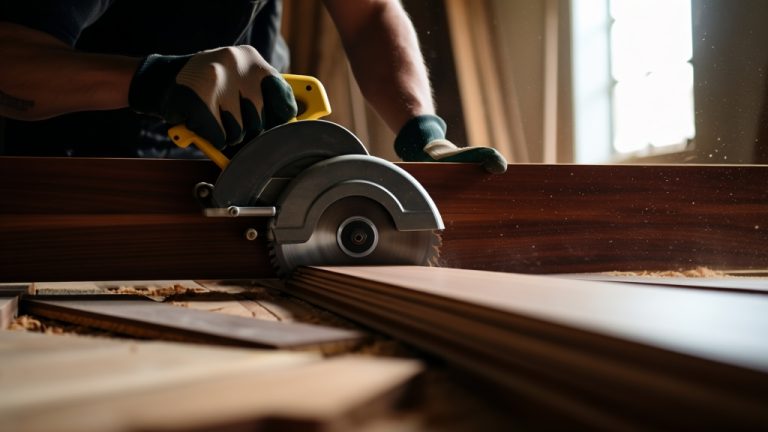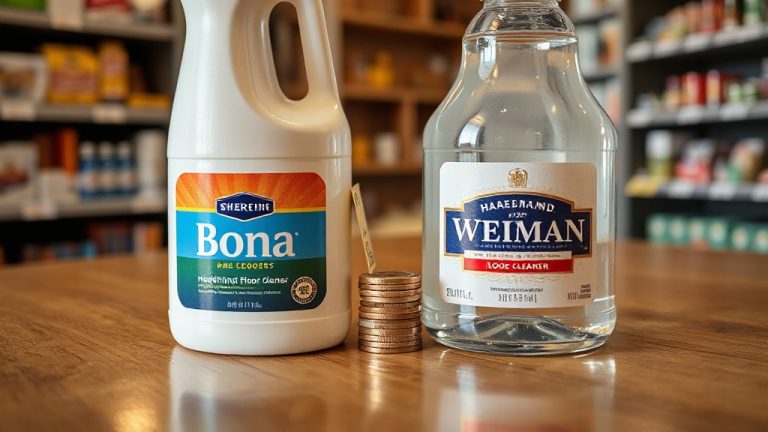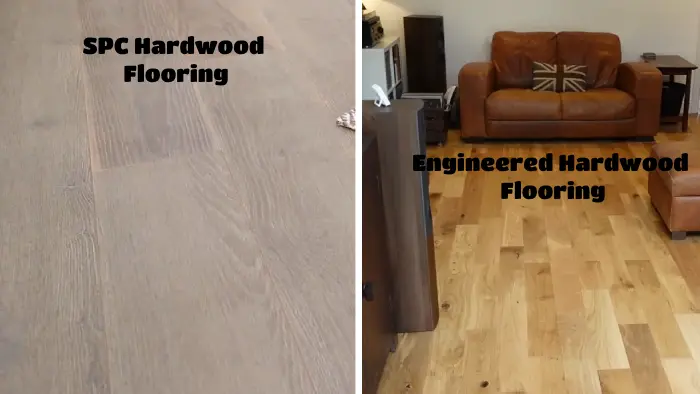You’ll love maple if you want a smooth, light floor with a modern, minimalist vibe. Its fine grain creates a serene, uniform look but shows scratches more easily. Oak offers warmer tones with bold, varied grain that hides wear and adds rustic charm.
Maple’s harder surface resists dents, while oak’s open grain soaks up stains beautifully. Both age differently, giving your space distinct character. Keep exploring, and you’ll find the perfect fit for your style and lifestyle.
Key Takeaways
- Maple has a light, creamy color with a fine, uniform grain ideal for modern, minimalist designs, while oak features richer tones and pronounced grain for traditional styles.
- Maple is harder and more dent-resistant (Janka ~1450), making it suitable for high-traffic areas, whereas oak’s open grain better conceals scratches and wear.
- Maple requires careful staining with conditioners to avoid blotchiness, while oak accepts a wide range of stains and finishes due to its porous grain.
- Maple flooring typically costs less ($5–$12/sq ft) but may have higher installation costs; oak is pricier ($15–$30/sq ft) but more widely available.
- Maple maintains a consistent creamy tone that may yellow slightly, while oak develops a warm patina and deepens in color over time.
Maple vs Oak Hardwood Flooring Comparison
| Feature | Maple Hardwood | Oak Hardwood |
|---|---|---|
| Appearance | Light, creamy color with fine, uniform grain | Richer tones with bold, varied grain |
| Style | Modern, minimalist vibe with subtle elegance | Traditional, rustic charm |
| Durability | Higher hardness with greater dent resistance | Open grain that hides wear better |
| Scratch Visibility | Shows scratches more easily | Hides scratches due to grain pattern |
| Staining | Light stains and natural look preferred | Wide range including dark stains |
| Aging | Yellows slightly over time, maintains light tones | Ages with distinct character |
| Maintenance | Requires special refinishing techniques | Easier stain customization |
| Best For | Busy homes needing dent resistance | Spaces wanting visual warmth and character |
Appearance and Grain Characteristics
When choosing between maple and oak flooring, you’ll notice that their appearances and grain patterns set distinctly different moods.
Maple’s light, creamy hues create a bright, airy ambiance, with a subtle, fine grain that lends a smooth, minimalist feel perfect if you want a clean, modern look. Its uniformity helps rooms feel more spacious and serene.
Maple floors have creamy, blondish hues with fine, subtle grain patterns and occasional swirls, enhancing their understated beauty. Maple is also a harder wood species (1450 on the Janka Hardness Scale), making it a durable choice for busy areas.
Oak, on the other hand, offers richer tones, red oak’s pinkish hues or white oak’s nutty browns, with pronounced, varied grain patterns that add character and movement. This grain makes oak a natural focal point, bringing warmth and depth to your space.
While maple keeps things understated and sleek, oak delivers dynamic texture and traditional charm, allowing you to tailor your room’s personality with ease.
Hardness and Durability Comparison
When choosing between maple and oak flooring, understanding their Janka hardness ratings helps you gauge durability—maple generally offers a harder surface.
The grain density plays a key role in wear resistance, with oak’s open grain concealing scratches better, while maple’s dense grain resists dents more effectively.
Maple is also known as the hardest domestic hardwood with a Janka hardness of approximately 1,450, making it ideal for high-traffic areas.
Proper maintenance, including regular cleaning and prompt repair of damages, is essential to preserve the floor’s appearance and longevity, as recommended for engineered hardwood care.
Janka Hardness Ratings
Although both maple and oak offer timeless hardwood flooring options, their Janka hardness ratings reveal subtle yet impactful differences in durability and wear resistance.
Hard Maple leads with a rating of 1450, making it harder and more dent-resistant than both Red Oak (1290) and White Oak (1360). This means your floors will better withstand daily impact and maintain their beauty longer.
Soft Maple, however, rates much lower at around 950, making it less suited for high-traffic areas.
- Hard Maple resists dents and scratches effectively
- Oak’s open grain conceals minor wear better
- Maple suits busy homes with pets and children
- Oak offers excellent refinishing potential, which is possible due to its ease of refinishing
- Hard Maple’s light color may show wear more visibly, so regular maintenance with gentle cleaning is recommended.
Grain Density Impact
Beyond Janka hardness ratings, the grain density of maple and oak plays a significant role in how these woods wear and age in your home. Maple’s tight, dense grain creates a smooth, uniform surface that resists denting and deformation, offering superior structural strength and moisture resistance.
Additionally, Maple offers a more subtle, consistent grain with occasional swirls, which enhances its refined appearance. When selecting engineered hardwood floors, evaluate the wood species to ensure a harmonious match with your existing flooring.
However, this fine grain also makes scratches and surface wear more visible, requiring more frequent refinishing to keep that pristine look. Oak, with its pronounced, open grain, naturally camouflages scratches and dents, aging gracefully while absorbing shocks through subtle flexibility.
Its grain texture allows easier stain absorption and touch-ups, extending visual freshness. When choosing between them, consider whether you prefer maple’s sleek rigidity or oak’s textured resilience to match your lifestyle and aesthetic goals.
Wear Resistance Factors
Since durability defines how well your floors endure daily life, understanding the hardness and wear resistance of maple and oak is essential. Maple’s higher Janka hardness (1,450) means it resists dents better than white oak (1,360) and red oak (1,290), making it ideal for busy spaces.
However, maple’s smooth grain can reveal scratches more easily, while oak’s open grain disguises wear gracefully. Both woods last generations with care, but maple’s toughness extends time between refinishing.
Treating hardwood floors with fire retardant products can enhance safety without compromising durability.
- Maple offers superior dent resistance for high-traffic areas
- Oak’s grain camouflages scratches, preserving appearance longer
- Both require similar maintenance and refinishing routines
- Maple suits commercial or active household environments
- Oak balances durability with natural aesthetic wear concealment
- Selecting the right species helps match flooring to your lifestyle and design preferences.
Staining and Finishing Differences
When choosing between maple and oak, you’ll notice that maple’s dense grain makes staining tricky. It often requires special conditioners or prefinished options to avoid blotchiness. Oak’s open grain welcomes a wider range of rich, even stains. This gives you more freedom to customize your floor’s look.
Understanding these differences helps you select the finish that best complements your style and the wood’s natural beauty. Additionally, ensuring proper acclimation duration before finishing can prevent staining issues caused by moisture content variations in the wood.
Staining Challenges
Although both maple and oak offer beautiful hardwood flooring options, staining them presents distinct challenges that affect the final look. Maple’s tight grain often leads to uneven absorption, causing blotchy finishes unless you use a wood conditioner and precise sanding.
Oak, with its open-grain structure, readily soaks up stain, delivering more consistent and versatile color outcomes. When staining these woods, keep in mind:
- Maple needs wood conditioner to prevent blotchiness
- Lighter stains suit maple best for even tone
- Oak’s porosity allows deeper, uniform stain penetration
- Proper surface preparation is essential for both
- Over-staining or skipping conditioner can ruin the finish
Additionally, maintaining your floors with gentle cleaning methods like sweeping or vacuuming with soft attachments helps preserve the finish and keep the stain looking vibrant over time.
Finish Options
Because the finish you choose directly shapes your floor’s character and longevity, understanding the distinct options for maple and oak is key. Maple’s light color and fine grain shine best with natural or clear finishes, preserving its modern, consistent look.
Matte finishes, known for their low sheen and minimal light reflection, can enhance maple’s subtle elegance by adding a cozy, understated ambiance. Oak’s versatility lets you explore rich stains, traditional or distressed finishes, and natural oils that highlight its dramatic grain and warm ambiance.
Additionally, oak’s wide range of colors from light blonde to deep reddish-brown provides ample opportunities to customize the finish to suit various interior design styles.
| Finish Type | Maple Hardwood | Oak Hardwood |
|---|---|---|
| Stain Options | Light stains, natural look | Wide range, including dark stains |
| Protective Coatings | Clear coats, polyurethane | Natural oils, polyurethane |
| Aesthetic Focus | Modern, subtle elegance | Traditional, rustic charm |
Color Stability and Aging Effects
As you consider the lasting beauty of your hardwood floors, understanding how maple and oak respond to color changes and aging can guide your choice. Maple offers a creamy, uniform look that softens subtly over time but reveals scratches more easily.
Note that some engineered wood flooring products, including maple, may contain formaldehyde emissions from adhesives used in manufacturing. Oak’s rich grain patterns deepen and mellow, masking wear and enhancing character gracefully.
Both woods age uniquely, influencing your floor’s evolving aesthetic.
- Maple maintains light tones but may yellow slightly with age and wear.
- Oak develops a warm patina, with colors deepening naturally.
- Maple’s smooth surface shows wear prominently; oak’s grain conceals it.
- Oak’s open grain allows more stain customization but is vulnerable to UV changes.
- Maple can be prone to slight warping; oak remains more dimensionally stable over time.
- Additionally, maple is less porous, making it more resistant to dents and scratches compared to oak.
Cost Factors and Market Availability
When choosing between maple and oak flooring, you’ll find that cost and market availability play significant roles in your decision. Maple flooring typically ranges from $5 to $12 per square foot, while red oak costs $15 to $30, and white oak sits between $18 to $28.
Selecting the right wood type also depends on ensuring compatibility with sealants to protect and enhance the floor’s durability. Despite maple’s moderate popularity, oak is more widely available, often making it easier and quicker to source.
Maple’s fine grain and density can increase installation costs due to more challenging cutting and fitting, whereas oak’s relative ease keeps labor expenses lower. Regional preferences also impact availability, with oak more commonly harvested in North America.
Additionally, installation costs for maple are generally around $8 to $12 per square foot, reflecting its higher durability compared to other woods. Considering these factors helps you balance budget, style, and supply, ensuring your flooring choice aligns with your aesthetic vision and practical needs.
Maintenance and Longevity Considerations
Although both maple and oak floors demand regular care to keep their beauty intact, their maintenance needs and longevity differ in ways that can influence your choice.
Maple’s tighter grain shows scratches more clearly, requiring frequent refinishing and careful cleaning. Meanwhile, oak’s open grain hides wear better and stains more evenly.
Maple’s tight grain reveals scratches easily, while oak’s open grain better hides wear and accepts stains evenly.
Maple’s higher hardness offers greater dent resistance, making it ideal for busy homes. However, it demands special refinishing techniques. Oak provides easier stain customization and can visually extend finish life.
Both woods can be sustainable if sourced responsibly, adding an environmental benefit to your flooring decision.
- Regular sweeping and immediate spill cleanup prevent damage for both woods
- Maple’s smooth grain needs protective finishes to resist scratches
- Oak conceals dents and scratches, reducing visible wear
- Refinishing maple requires specialized sanding, oak absorbs stain easily
- Both can last decades with proper care and periodic refinishing
Frequently Asked Questions
Which Wood Is More Environmentally Sustainable to Harvest?
You’ll find that harvesting faster-growing trees offers a more sustainable path. Because they mature quickly, they let forests replenish sooner, reducing ecological strain. Choosing wood that requires fewer chemicals to treat helps protect indoor air quality and lowers environmental toxins.
When you opt for materials with shorter rotation periods and minimal chemical needs, you support healthier forests and homes, making your flooring choice genuinely eco-friendly and responsible.
How Do Maple and Oak Flooring Affect Indoor Air Quality?
You’ll appreciate how both maple and oak floors enhance your indoor air quality by resisting dust, pollen, and pet dander buildup thanks to their smooth surfaces. Their low VOC emissions keep your home’s air cleaner, especially when finished with eco-friendly sealants.
Maple’s hardness means fewer dents trap allergens, making maintenance easier. With regular cleaning, these hardwood floors create a healthier, fresher environment that supports your well-being beautifully.
Are There Health Concerns Related to Allergens in Maple or Oak Wood?
Imagine dust bunnies from the Victorian era invading your modern home, that’s what allergens can feel like. You’ll want to avoid off-gassing by choosing prefinished hardwood floors, as unfinished ones can release irritants during refinishing.
Keep humidity steady between 30-50% to prevent cracks where allergens hide. Use gentle, hypoallergenic cleaners to maintain that pristine surface. With proper care, your floors become an allergen-resistant haven, promoting healthier indoor air and peace of mind.
Can Maple or Oak Flooring Be Installed Over Radiant Heating Systems?
You can install hardwood flooring over radiant heating, but you’ll want to choose wisely for stability and performance. Engineered wood is your best bet, as it handles heat fluctuations smoothly. If you prefer solid wood, pick species known for minimal movement and keep planks narrow.
Maintain consistent humidity and confirm the floor thickness doesn’t block heat. Floating installations protect your system and promote longevity, keeping your floors both beautiful and durable.
Which Wood Type Better Suits Pet-Friendly Homes?
You might worry scratches will ruin your floors, but choosing the right wood makes all the difference. For pet-friendly homes, opt for maple’s dense, smooth surface offering excellent dent resistance and a sleek, light look that brightens your space.
Though minor scratches show more, regular maintenance and the right finish keep it stunning. Alternatively, oak’s warm tones and open grain cleverly mask wear, perfect if you prefer a cozier vibe.
Finding Your Flooring Fit: Style, Function, and Flooring Harmony
When choosing between maple and oak hardwood flooring, consider how each wood’s unique grain and color will complement your space over time. While oak’s pronounced grain offers rustic charm, maple’s smooth, subtle texture lends a modern elegance.
Contrary to popular belief, maple’s hardness doesn’t compromise its warmth. You’ll want to weigh cost, finish options, and maintenance to guarantee your floors not only last but also evolve beautifully with your lifestyle and design vision.
- Premium Craftsmanship: Handcrafted from solid maple and hickory, ensuring durability and timeless…
- Healthier Indoor Air: FloorScore certified to reduce formaldehyde emissions and promote a healthier…
- Easy Installation: Suitable for both upstairs and ground level installations, using nail down or…
Last update on 2025-12-03 / Affiliate links / Images from Amazon Product Advertising API





